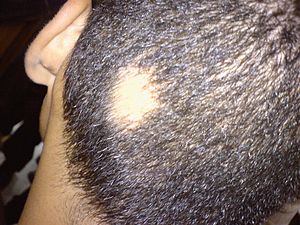Alopecia areata
| Alopecia areata | |
|---|---|
 |
|
| Alopecia areata | |
| Classification and external resources | |
| Specialty | Dermatology |
| ICD-10 | L63 |
| ICD-9-CM | 704.01 |
| OMIM | 104000 |
| DiseasesDB | 430 |
| MedlinePlus | 001450 |
| eMedicine | derm/14 |
| MeSH | D000506 |
Alopecia areata, also known as spot baldness, is an autoimmune disease in which hair is lost from some or all areas of the body, usually from the scalp due to the body's failure to recognize its own body cells and subsequent destruction of its own tissue. Often it results in bald spots on the scalp, especially in the first stages. In 1–2% of cases, the condition can spread to the entire scalp (alopecia totalis) or to the entire skin (alopecia universalis).
There are two types: (1) scarring alopecia, where there is fibrosis, inflammation, and loss of hair follicles, and (2) nonscarring alopecia, where the hair shafts are gone but the hair follicles are preserved, making this type of alopecia reversible. Conditions resembling alopecia areata, and having a similar cause, occur also in other species.
Typical first symptoms of alopecia areata are small bald patches. The underlying skin is unscarred and looks superficially normal. Although these patches can take many shapes, they are usually round or oval. Alopecia areata most often affects the scalp and beard, but may occur on any part of the body with hair. Different areas of the skin may exhibit hair loss and regrowth at the same time. The disease may also go into remission for a time, or may be permanent. It is common in children.
The area of hair loss may tingle or be painful.
The hair tends to fall out over a short period of time, with the loss commonly occurring more on one side of the scalp than the other.
Exclamation point hairs, narrower along the length of the strand closer to the base, producing a characteristic "exclamation point" appearance, are often present.
When healthy hair is pulled out, at most a few should come out, and ripped hair should not be distributed evenly across the tugged portion of the scalp. In cases of alopecia areata, hair will tend to pull out more easily along the edge of the patch where the follicles are already being attacked by the body's immune system than away from the patch where they are still healthy.
Nails may have pitting or trachyonychia.
Alopecia areata is thought to be a systemic autoimmune disorder in which the body attacks its own anagen hair follicles and suppresses or stops hair growth. For example, T cell lymphocytes cluster around affected follicles, causing inflammation and subsequent hair loss. A few cases of babies being born with congenital alopecia areata have been reported, but these are not cases of autoimmune disease, because infants are born without fully developed immune systems.
...
Wikipedia
